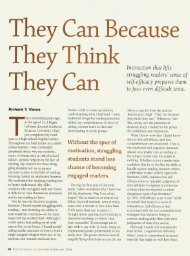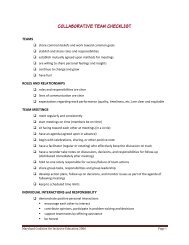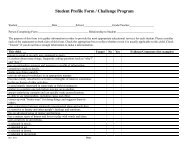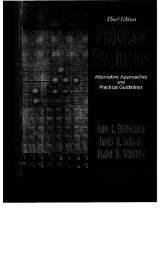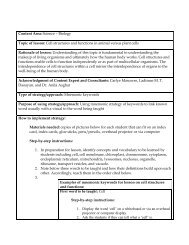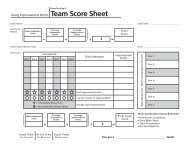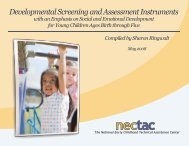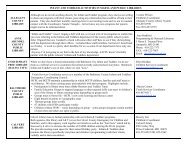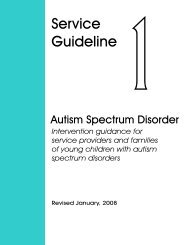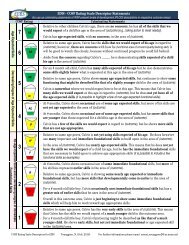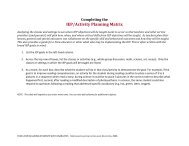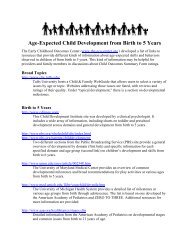Early Intervention Early Childhood - CTE - Online Learning ...
Early Intervention Early Childhood - CTE - Online Learning ...
Early Intervention Early Childhood - CTE - Online Learning ...
- No tags were found...
You also want an ePaper? Increase the reach of your titles
YUMPU automatically turns print PDFs into web optimized ePapers that Google loves.
Hanson, M. J., Beckman, P. J., Horn, E., Marquart, J., Sandall, S. R., Greig, D., & Brennan, E.(2000). Entering preschool: Family and professional experiences in this transition process.Journal of <strong>Early</strong> <strong>Intervention</strong>, 23(4), 279-93.ABSTRACT: A study investigated the experiences of 22 families of children (age 3) with disabilitiesas they entered, participated in, and exited the transition process. The shift in service deliverymodels was often problematic, families were given a limited choice of preschool programs, and fewprograms offered inclusive service models.Hanson, M. J. (1999). <strong>Early</strong> transitions for children and families: Transitions from infant/toddlerservices to preschool education. Reston, VA: ERIC Clearinghouse on Disabilities and GiftedEducation, Council for Exceptional Children. Retrieved March 25, 2004 fromhttp://ericec.org/digests/e581.htmlABSTRACT: This Digest summarizes what is known about the successful transition of childrenwith disabilities from infant/toddler services to preschool education. The ideal transition process isdefined and characteristics of an ideal process such as meeting individual needs and providinguninterrupted services are listed. Also noted are issues in the transition process such as differences ineligibility processes and philosophical shifts in intervention models. The paper focuses on fivestrategies which have been demonstrated to be effective: (1) interagency coordination; (2) preparation,information exchange, and training among sending programs, receiving programs, and families;(3) family support; (4) child preparation; and (5) staff training and collaboration. Some findingsof the <strong>Early</strong> <strong>Childhood</strong> Research Institute on Inclusion are noted concerning families’ and professionals’experiences and perceptions during the transition process, their expectations and concerns,and factors that affected or influenced the transition process and outcome.Lazzari, A. M. (1991). The transition sourcebook: A practical guide for early interventionprograms. Tucson, AZ: Communication Skill Builders.ABSTRACT: The purpose of this book is to provide professionals and parents with practical guidelinesfor effecting positive transitions for infants, toddlers, preschool children, and their families.The text is supplemented with numerous forms, checklists, timelines, and charts that programs canuse in developing or modifying transition strategies and parents can use as they plan their child’stransitions. The appendices provide training suggestions and materials for use at the preservice orinservice levels or with parents. It is anticipated that program staff will modify these materials tomeet the unique needs for transition in various settings, as mandated by state and local regulationsand practices.Malveaux, J. A., Welker, P. L., & Norlin, J. W. (2003). Transitioning from Part C to Part B:Practical guidance and legal issues. Horsham, PA: LRP Publications.ABSTRACT: A host of issues can arise when transitioning a child from Part C to Part B. Sometimesthe problems associated with this transition lead to legal resolution, either at due process or in thecourts. This is especially true when parties involved disagree on placement, service delivery andindividualized education programs. Other issues such as eligibility, and parental involvement andconsent also have led to due process hearings. This document discusses the range of issuesinvolving Part C to Part B transitioning that often lead to due process, including family involvement,Part C/Part B collaboration, IFSP and IEP differences and service delivery. It includes summaries oflegal decisions involving those topics, as well as articles describing transition issues. All judicialand administrative decisions that have been published in LRP Publications’ Individuals withDisabilities Education Law Report and <strong>Early</strong> <strong>Childhood</strong> Law and Policy Reporter are cited to thosepublications.page 4



